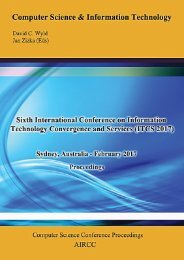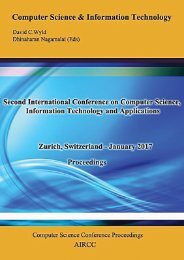CoSIT 2017
Fourth International Conference on Computer Science and Information Technology ( CoSIT 2017 ), Geneva, Switzerland - March 2017
Fourth International Conference on Computer Science and Information Technology ( CoSIT 2017 ), Geneva, Switzerland - March 2017
You also want an ePaper? Increase the reach of your titles
YUMPU automatically turns print PDFs into web optimized ePapers that Google loves.
Computer Science & Information Technology (CS & IT) 53<br />
The safety margin in the acquisition rate is also useful to have a redundancy of information to be<br />
able to face to problems in video analysis.<br />
Considering that the total video time is approximately between 2 and 5 second, the total number<br />
of frame that should be analysed is between 80 to 200 frames. This number is acceptable because<br />
it can be processed without problems with a commercial PC, so the requirement of non-specialist<br />
equipment is satisfied.<br />
After having done a sampling from the video, it is possible to analyse firstly all the frames with<br />
the mosaicking procedure and then frame by frame by the barycentre identification.<br />
4.3. Mosaicking<br />
Having extracted from the video the frames, the second step of the procedure is mosaicking.<br />
Image mosaicking is a computational techniquethat exploit the presence of common features in a<br />
set of pictures[20]in images to a picture, called panorama[21].<br />
Image mosaicking is a general [22] technique of image processing that has been applied to many<br />
fields, from medicine [23] to power plant inspection [24].<br />
This technique is based on the identification of a set of features that are kept invariant during the<br />
most common transformations between pictures. The features of different pictures are matched<br />
and then the geometric transformation is identified. In this step to each picture a transfer function<br />
is associated [25].<br />
At this point it is possible to wrap all the image in one image, called panorama. The<br />
panoramacan be interpreted in this context as the common background to all the pictures.<br />
In image mosaicking, it is possible to have different types of transformations[21]: testing many of<br />
them, it has been seen that the affine transformation is the best one for this application [26].<br />
This step can solve two common problems related to the diving video: the first one is that the<br />
camera can have vibrations due to the low quality of the absence of an appropriate equipment.<br />
The second problem solved by mosaicking, is the fact that often, high quality video follows the<br />
diver, so the reference system changes (also a lot) from frame to frame.<br />
1. Definition of the reference frame<br />
2. Individuation of the main features of the reference frame<br />
3. For all the frames do<br />
4. Identification of the main feature of the frame<br />
5. Feature matching between current frame and previous one<br />
6. Definition of an appropriate geometric transformation<br />
7. End For<br />
8, Definition of the size of the panorama<br />
9. Empty panorama creation<br />
10. For all the frames do<br />
11. Frame transformation in the global reference system<br />
12. Transformed frame added to the panorama<br />
13. End For<br />
Algorithm 1. Mosaicking procedure





